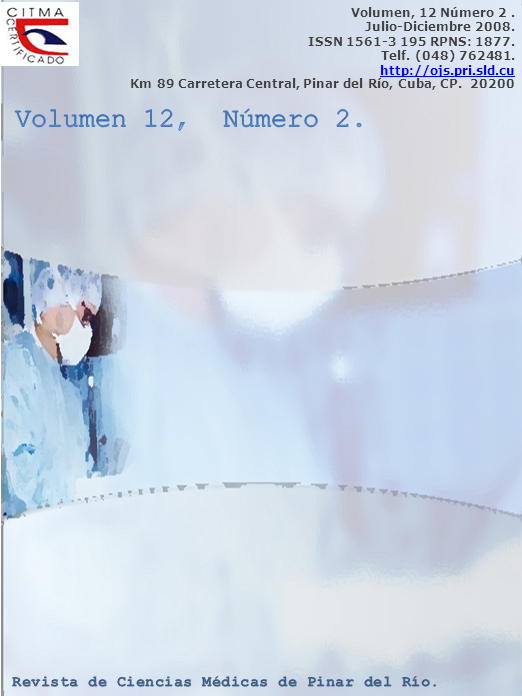Euthanasia and Legislation
Abstract
Concepts related to Euthanasia as Disthanasia and Ortothanasia are reviewed as well as the different types of Euthanasia, such as the Voluntary Euthanasia, the non Voluntary Euthanasia and the Involuntary Euthanasia, the Eugenesic Euthanasia. The different possibilities from the legal point of view are assessed; the Euthanasia may be regulated or not, the first type of Euthanasia may be regulated by penal rules. i.e., the regulation may be a typical delictive figure or to be within another legal type and in case of not penal regulation, it may be by administrative rules and in such case it may be treated of permissive regulations or not. These possibilities are valuated exposing how they are classified in the Cuban Penal Code and which is the authors´s criterion. The countries where the classification of Euthanasia has been treated or attained from different ways are exposed as well as the results of Holland's study before the decriminalization of Euthanasia and the behaviour in terminal patients in this year. Finally, the authors´s criterion about the legal regulation of Euthanasia is exposed.Downloads
References
1. Andorno R. Biomedicina and internacional human rights law: in search of a global consensus. Bulletin of the World Health Organization. 2002; 80: 959-953.
2. Comité de Ética de la Sociedad Española de Cuidados Paliativos.Centro de Documentación de Bioética. Consentimiento informado en cuidados paliativos. Diario Méd; 24 de abril de 2002, Disponible en: http://www.unav.es/cdb/secpal3.html
3. Organización Médica Colegial y Sociedad Española de Cuidados Paliativos. Declaración sobre la atención médica al final de la vida. Rev Esp Geriatr Gerontol 2002; 37: 225-30
4. Case Pretty V. The United Kingdom. Application no.2002;46(2).
5. Porta Sales J. Sedación Paliativa. En Porta J, Gómez-Batiste X, Tuca A. Manual de control de síntomas en pacientes con cáncer avanzado y terminal. 2ª ed. Madrid: Arán, 2008. p 325-36
6. Ollero A. Discurso pronunciado en las Cortes españolas en contra de la despenalización de la Eutanasia. Diciembre; 2002.
7. Montero E. ¿Hacia una legalización de la Eutanasia voluntaria? Cuadernos de Bioética de Galicia. 2002; 44: 27-43.
8. Medina C D, Jiménez J F, Rodríguez B, Farrerons l. Reflexiones en torno a la regulación legal de conductas eutanasicas. Cuadernos de Bioética de Galicia. 16: 50-52.
9. Marcos A M. Eutanasia: relevancia jurídico penal del consentimiento. (Análisis a la luz del Código Penal vigente) Cuadernos de Bioética de Galicia. 16: 53-62.
10. Kass L. Eutanasia y autonomía de la persona. Vivir y morir con dignidad. Cuadernos de Bioética de Galicia. 1998; 4: 24-28.
11. Asociación Española de Bioética y Ética Médica. Eutanasia, suicidio asistido y profesionales de la salud. Cuadernos de Bioética. Enero-Abril 2001; 12(44): p.15-26
12. Jochemsen H. ¿La Eutanasia voluntaria bajo control? Nuevas pruebas empíricas desde Holanda. Cuadernos de Bioética de Galicia. 39: 549-553.
13. Eijik W J Eutanasia: contra quinto mandamiento. Cuadernos de Bioética de Galicia. 1996; 3: 311-318.
How to Cite
Issue
Section
License
Authors who have publications with this journal agree to the following terms: Authors will retain their copyrights and grant the journal the right of first publication of their work, which will be publication of their work, which will be simultaneously subject to the Creative Commons Attribution License (CC-BY-NC 4.0) that allows third parties to share the work as long as its author and first publication in this journal are indicated.
Authors may adopt other non-exclusive license agreements for distribution of the published version of the work (e.g.: deposit it in an institutional telematic archive or publish it in a volume). Likewise, and according to the recommendations of the Medical Sciences Editorial (ECIMED), authors must declare in each article their contribution according to the CRediT taxonomy (contributor roles). This taxonomy includes 14 roles, which can be used to represent the tasks typically performed by contributors in scientific academic production. It should be consulted in monograph) whenever initial publication in this journal is indicated. Authors are allowed and encouraged to disseminate their work through the Internet (e.g., in institutional telematic archives or on their web page) before and during the submission process, which may produce interesting exchanges and increase citations of the published work. (See The effect of open access). https://casrai.org/credit/



